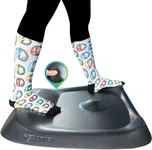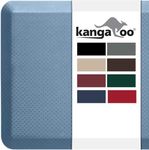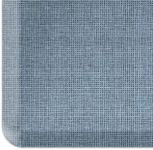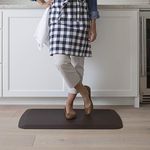Buying Guide for the Best Anti Fatigue Mats
Choosing the right anti-fatigue mat can make a big difference in your comfort and well-being, especially if you spend long hours standing at work or at home. The main goal of an anti-fatigue mat is to reduce the strain on your legs, feet, and lower back by providing a cushioned surface that encourages subtle movement. When shopping for an anti-fatigue mat, it's important to consider several key features to ensure you get the best fit for your needs and environment.ThicknessThickness refers to how deep or cushioned the mat is, usually measured in inches or millimeters. This is important because a thicker mat generally provides more comfort and support, helping to reduce fatigue. Mats typically range from about 1/2 inch to 1 inch thick. Thinner mats (around 1/2 inch) are suitable for light use or areas where you need to move carts or chairs over the mat. Medium thickness (about 3/4 inch) is a good balance for most people who stand for moderate periods. Thicker mats (1 inch or more) offer maximum cushioning and are best for prolonged standing, but they may be too soft for tasks that require stable footing. Think about how long you’ll be standing and how much cushioning you prefer to guide your choice.
MaterialThe material of an anti-fatigue mat affects its durability, comfort, and ease of cleaning. Common materials include foam, rubber, gel, and vinyl. Foam mats are lightweight and comfortable but may wear out faster in high-traffic areas. Rubber mats are more durable and resistant to wear, making them ideal for industrial or commercial settings. Gel mats offer a soft, supportive feel and are often used in kitchens or offices. Vinyl mats are easy to clean and can handle spills well. Consider where you’ll use the mat and how much traffic it will get to help you decide which material is best for you.
Surface TextureSurface texture refers to the pattern or finish on the top of the mat. This is important for both comfort and safety, as a textured surface can help prevent slipping and provide a pleasant feel underfoot. Smooth surfaces are easy to clean and comfortable for bare feet, but may be slippery if wet. Lightly textured or patterned surfaces offer better grip and are safer in environments where spills are likely. If you’re using the mat in a kitchen or workshop, a textured surface is a good choice. For office or home use, a smoother surface may be more comfortable.
Size and ShapeSize and shape determine how much area the mat will cover and how well it fits your workspace. Mats come in various sizes, from small ones for standing desks to large runners for kitchen counters or assembly lines. Rectangular mats are the most common, but you can also find contoured or corner mats for specific spaces. Measure the area where you plan to use the mat and think about how much room you need to move around. Choose a size that covers your standing area without being too large or getting in the way.
Edge DesignEdge design refers to how the sides of the mat are shaped. Beveled or sloped edges are important because they reduce the risk of tripping and make it easier to step on and off the mat. Mats with straight or raised edges can be a tripping hazard, especially in busy areas. If you’ll be moving carts or chairs over the mat, beveled edges are especially helpful. Always look for a mat with gently sloped edges for safety and convenience.
Ease of CleaningEase of cleaning is about how simple it is to keep the mat free from dirt, spills, and stains. Some mats are designed to be wiped clean with a damp cloth, while others can be hosed off or even machine washed. If you’re using the mat in a kitchen, workshop, or any area prone to spills, choose a mat that is water-resistant and easy to clean. For office or home use, a mat that can be quickly wiped down is usually sufficient.














